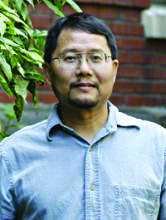In classical pharmacology, drug-receptor interactions are considered under static conditions. A relatively new concept, mechanopharmacology, differs in that the normal mechanical environment of a tissue is a factor, with potentially significant impacts on function.
Mechanopharmacology of Airway and Airway Smooth Muscle (A86)
2:15-4:15 p.m., Sunday
Ballroom D One (Level 3), KBHCCD
“It is only recently that we recognized that tissue response to the action of drugs in the moving organs is affected by the movements. For example, airways dilate more in response to bronchodilators in the presence of pressure oscillation due to the action of breathing,” said Chun Seow, PhD, ATSF, professor at the University of British Columbia, in Vancouver, BC, Canada.

Chun Seow
In organs “living” in a mechanically dynamic environment, drug actions should no longer be considered as simple agonist-receptor-based reactions, said Dr. Seow, co-chair of this afternoon’s session on mechanopharmacology. Normal and disease-related changes in the mechanical environment of lung tissue, for example, may have an impact on drug-dose response behavior.

Peter Noble
“Our recommendation is that drug-design models be revised to incorporate contemporary knowledge on mechanotransduction that ultimately determine drug efficacy,” said Dr. Seow.
Although focused and solid basic research is first required to develop an improved understanding of mechanopharmacology, there are important clinical implications. For example, changes in mechanical properties of lung tissues may contribute to the proportion of patients who do not have a good response to medications that are effective in other patients. The synergistic effects of bronchodilators when administered in the presence of airway pressure oscillation, either due to natural breathing maneuver or artificially imposed pressure wave, have the potential to reduce drug dosage and, therefore, reduce side effects.
“With mechanical intervention, a whole new venue of drug targets will become available, which will lead to improvements in response and quality of life for patients,” said Dr. Seow.
“The session is a wonderful demonstration of how focused basic research, both collaborative and competitive, generates knowledge that can be translated to clinical practice,” said Peter Noble, PhD, senior lecturer at the University of Western Australia in Perth, also a co-chair of the session. “This knowledge is borne out of pure scientific curiosity, without an initial application in mind. The main message is that drugs act differently in tissues that constantly move.”
The presentations in the session will address the mechanical effects on drug action, specifically, the enhanced drug action in the presence of mechanical movements, the molecular pathways perturbed by mechanical actions associated with breathing, and the incorporation of mechanical effects into drug screening.
Relevant for both scientists and clinicians, this session is designed to generate innovative thinking. For example, current laboratory-based technologies could be expanded to include consideration of mechanopharmacology, emerging technologies could be used to assess mechanical changes that may have an impact on treating patients, and mechanical devices could be developed to reduce drug dosage or even achieve therapeutic effects without drugs.
